

| An unusual Common Sandpiper at Eakring Flash April 2006 | |
| A prominent Nottinghamshire birdwatcher recently questioned the ID of this Sandpiper, present at Eakring Flash on April 17th 2006. The possibility that the bird was actually a Spotted Sandpiper was raised and several others also believed that the proposed new ID could be correct. | ||
| ............... | ||
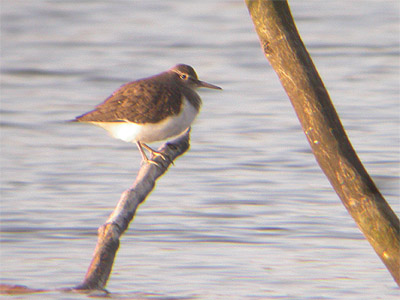 |
However, the question of a possible Common/Spotted
Sandpiper hybrid was raised by one former Nottinghamshire
birder who was sent the photos via email. On seeing the
photographs, most of the people that contributed to the
ensuing debate initially thought Spotted Sandpiper.
Closer inspection then began to throw doubts on their
immediate identification, as the bird showed several
features indicating Common Sandpiper. Initial observation/sighting Shortly after arriving at Eakring Flash on April 17th 2006, I immediately noticed a small wader on the dead branches in the centre of the flash. Viewing through binoculars revealed what I quickly identified as a Common Sandpiper. |
|
| ............... | ||
| I didn't view
the bird through the scope, as (with the camera already
attached) I took the opportunity of taking some distant
photographs to better those I had taken of another Common
Sandpiper present on a gloomy morning in April 2005. I
was delighted at the record as Common Sandpiper still
remains a rarity here, but as Wheatears had been in the
area for a number of days, I quickly moved on to Tug
Bridge Farm to check there. I had no reason to question my original ID and the picture was uploaded onto this website the same day. As far as I can remember, the bird never took flight during the time I was there and never called. If it had, then suspicions would certainly have been raised. October 2006 - Identification questioned I was contacted by Andy Hall of Notts Birdwatchers in late October, saying he had seen the photo labelled as Common Sandpiper on Eakringbirds.co.uk, but suspected that it was possibly a Spotted Sandpiper, as the bird showed some characteristics if that species. More photos of the bird were uploaded onto the internet and then I started to question my original ID. Once it had been pointed out, it did'nt look like most Common Sandpipers that I had seen well. Emails were sent to several other birding aquaintances and notice was also put onto the Notts Birdnews Yahoo Group. |
||
| Readers comments | Larger images of this bird can be found here | |
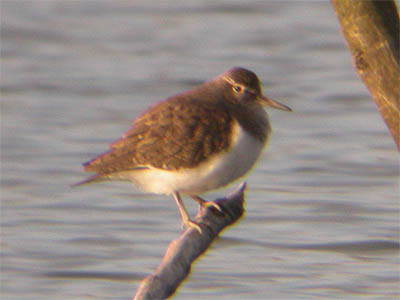 |
MD - Plus points for Spotted Sandpiper are the structure, it looks short tailed and dumpy, The head shape on Spotted Sandpiper is subtly different from Common Sandpiper, the forehead of a Spotted Sandpiper, to me at least, always appears steeper making the bill look less part of the face and the head appear slightly out of scale to the body, Common Sandpiper's face always seems to graduate into the bill. The bill itself is as I would expect a winter Spotted Sandpiper's bill to look and the colouration seems to be always more vivid than common with an obvious contrast between the mid section and the darker tip. The legs also look too bright for Common Sandpiper. Points against it being a Spotted Sandpiper - its at Eakring! Personally, I don't think it looks like a Common Sandpiper. | |
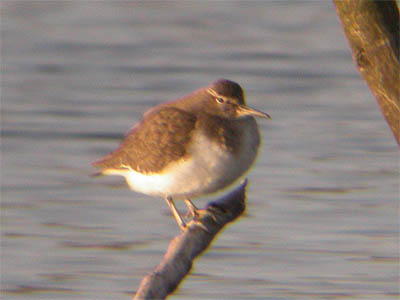 |
AH - For me the relatively prominent supercillium behind the eye, the slightly down-turned bill with darker tip, the structure of the bird (pot-bellied and short tail projection) make it a Spotted. However, as Neil says it's not quite right and I think the possibility of a hybrid does need to be considered. Of course photos or notes on the wing bar when the bird flew would help, but presumably these are not available. Not quite being able to see the tertials properly is the most frustrating part. At the very least it's a very, very interesting bird. | |
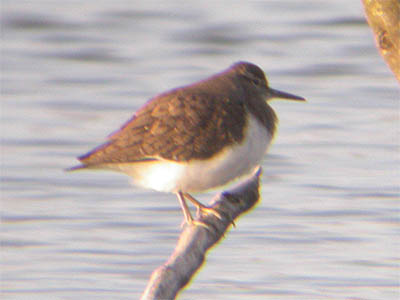 |
NG - Interesting bird! My immediate thought was Spotted, without studying it at all, just going on jizz alone. This bird looks short-tailed, certainly but on closer inspection things aren't as cut and dried as they seem. The legs look pale as does the bill, but is this an effect of the light? I feel Spotted's legs should be paler and the bill should be more two-toned. I cannot make out any notching on the tertials, (or if I can, it might be down to my imagination!) making this a Spotted. The supercilium certainly looks flared at the back of the eye, but is this a trick of the light or camera angle? The shortness of the tail could also be an effect of the camera angle. At some angles the eye-ring looks very prominent. In short, it doesn't look quite right for either Spotted or Common! | |
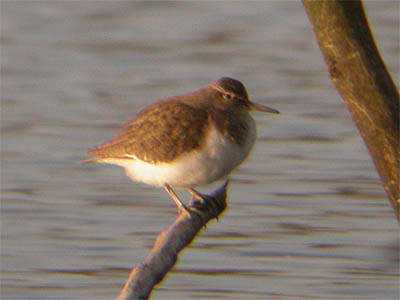 |
GW - Really interesting this. Supercilium extends well behind the eye and tail seems very short, pointing towards Spotted Sandpiper. Very pot-bellied as well. In your pictures, bill does seem to have a darker tip to it as well. Common Sand has no dark tip. Tertials look very plain in your pictures as well. | |
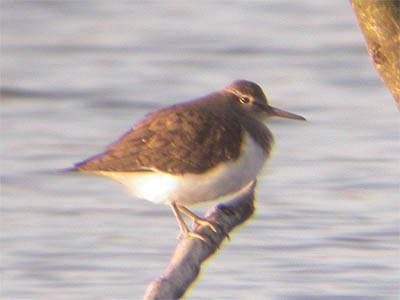 |
TW - A strong facial pattern, extremely well defined eye ring and fairly bold supercillium extending beyond the eye, are all characteristics of Spotted. Plus bill appears to have a darker tip and the tertials look to be plain, adding more evidence to Spotted. Tail is definitely long, difficult to judge if long enough to discount Spotted. Barring on wing coverts debatable? Hence there is much to argue for Spotted. | |
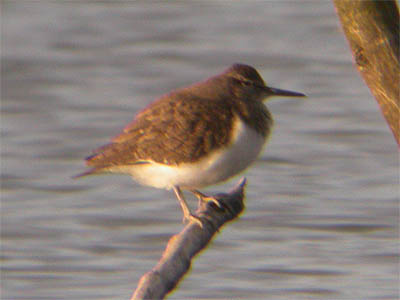 |
RB - One of the most crucial features in my book is the (relative) tail/wing lengths; this bird shows the tail projecting well beyond the wing tip. The breast patches are well developed and clearly delineated with no streaking - again suggestive of Common. Bare part colorations are equivocal. It is true that Spotted typically has straw-colored legs and a pale yellow base to the bill, but Common can tend that way too. Comments regarding coverts etc, are not very relevant here, since we are dealing with an adult rather than a juvenile/1st autumn. | |
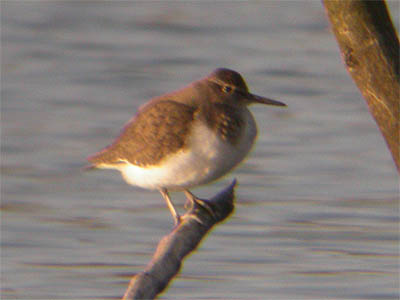 |
SM - I've not had much time to study the photos, but it looks an interesting bird. Some aspects of the jizz and a few plumage details suggest Spotted Sandpiper, but it seems unlikely to be a pure one as most or all should show at least some spotting on the underparts by mid April as far as I know. The bird does seem to be moulting into summer plumage as I think I can see some dark bars on the upperparts, at least on the upper scapulars, and on one of the tertials, but not any spots on the underparts. I presume when you photographed you thought it was a Common Sandpiper and so therefore did not bother taking notes on it? | |
| Identity
revealed as Common Sandpiper Howard Boughton sent photos to Birdguides for their experts to give an opinion. A unanimous verdict from Steve Whitehouse, Mush Ahmed and Johnny Mac, was that the bird was indeed a Common Sandpiper - adding that the bird was not straight-forward to identify and that it was an interesting bird. |
|